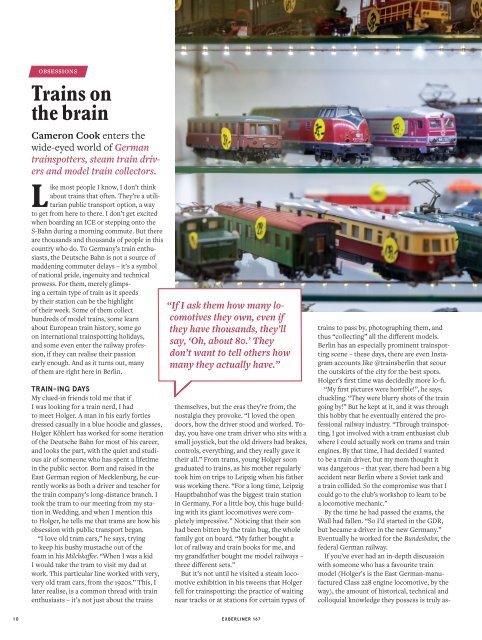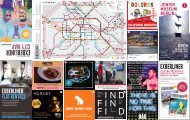Exberliner Issue 167, January 2018
You also want an ePaper? Increase the reach of your titles
YUMPU automatically turns print PDFs into web optimized ePapers that Google loves.
TRAINS<br />
OBSESSIONS<br />
Trains on<br />
the brain<br />
Cameron Cook enters the<br />
wide-eyed world of German<br />
trainspotters, steam train drivers<br />
and model train collectors.<br />
Like most people I know, I don’t think<br />
about trains that often. They’re a utilitarian<br />
public transport option, a way<br />
to get from here to there. I don’t get excited<br />
when boarding an ICE or stepping onto the<br />
S-Bahn during a morning commute. But there<br />
are thousands and thousands of people in this<br />
country who do. To Germany’s train enthusiasts,<br />
the Deutsche Bahn is not a source of<br />
maddening commuter delays – it’s a symbol<br />
of national pride, ingenuity and technical<br />
prowess. For them, merely glimpsing<br />
a certain type of train as it speeds<br />
by their station can be the highlight<br />
of their week. Some of them collect<br />
hundreds of model trains, some learn<br />
about European train history, some go<br />
on international trainspotting holidays,<br />
and some even enter the railway profession,<br />
if they can realise their passion<br />
early enough. And as it turns out, many<br />
of them are right here in Berlin.<br />
TRAIN-ING DAYS<br />
My clued-in friends told me that if<br />
I was looking for a train nerd, I had<br />
to meet Holger. A man in his early forties<br />
dressed casually in a blue hoodie and glasses,<br />
Holger Köhlert has worked for some iteration<br />
of the Deutsche Bahn for most of his career,<br />
and looks the part, with the quiet and studious<br />
air of someone who has spent a lifetime<br />
in the public sector. Born and raised in the<br />
East German region of Mecklenburg, he currently<br />
works as both a driver and teacher for<br />
the train company’s long-distance branch. I<br />
took the tram to our meeting from my station<br />
in Wedding, and when I mention this<br />
to Holger, he tells me that trams are how his<br />
obsession with public transport began.<br />
“I love old tram cars,” he says, trying<br />
to keep his bushy mustache out of the<br />
foam in his Milchkaffee. “When I was a kid<br />
I would take the tram to visit my dad at<br />
work. This particular line worked with very,<br />
very old tram cars, from the 1920s.” This, I<br />
later realise, is a common thread with train<br />
enthusiasts – it’s not just about the trains<br />
“If I ask them how many locomotives<br />
they own, even if<br />
they have thousands, they’ll<br />
say, ‘Oh, about 80.’ They<br />
don’t want to tell others how<br />
many they actually have.”<br />
themselves, but the eras they’re from, the<br />
nostalgia they provoke. “I loved the open<br />
doors, how the driver stood and worked. Today,<br />
you have one tram driver who sits with a<br />
small joystick, but the old drivers had brakes,<br />
controls, everything, and they really gave it<br />
their all.” From trams, young Holger soon<br />
graduated to trains, as his mother regularly<br />
took him on trips to Leipzig when his father<br />
was working there. “For a long time, Leipzig<br />
Hauptbahnhof was the biggest train station<br />
in Germany. For a little boy, this huge building<br />
with its giant locomotives were completely<br />
impressive.” Noticing that their son<br />
had been bitten by the train bug, the whole<br />
family got on board. “My father bought a<br />
lot of railway and train books for me, and<br />
my grandfather bought me model railways –<br />
three different sets.”<br />
But it’s not until he visited a steam locomotive<br />
exhibition in his tweens that Holger<br />
fell for trainspotting: the practice of waiting<br />
near tracks or at stations for certain types of<br />
trains to pass by, photographing them, and<br />
thus “collecting” all the different models.<br />
Berlin has an especially prominent trainspotting<br />
scene – these days, there are even Instagram<br />
accounts like @trainsberlin that scour<br />
the outskirts of the city for the best spots.<br />
Holger’s first time was decidedly more lo-fi.<br />
“My first pictures were horrible!”, he says,<br />
chuckling. “They were blurry shots of the train<br />
going by!” But he kept at it, and it was through<br />
this hobby that he eventually entered the professional<br />
railway industry. “Through trainspotting,<br />
I got involved with a tram enthusiast club<br />
where I could actually work on trams and train<br />
engines. By that time, I had decided I wanted<br />
to be a train driver, but my mom thought it<br />
was dangerous – that year, there had been a big<br />
accident near Berlin where a Soviet tank and<br />
a train collided. So the compromise was that I<br />
could go to the club’s workshop to learn to be<br />
a locomotive mechanic.”<br />
By the time he had passed the exams, the<br />
Wall had fallen. “So I’d started in the GDR,<br />
but became a driver in the new Germany.”<br />
Eventually he worked for the Bundesbahn, the<br />
federal German railway.<br />
If you’ve ever had an in-depth discussion<br />
with someone who has a favourite train<br />
model (Holger’s is the East German-manufactured<br />
Class 228 engine locomotive, by the<br />
way), the amount of historical, technical and<br />
colloquial knowledge they possess is truly as-<br />
10<br />
EXBERLINER <strong>167</strong>


















